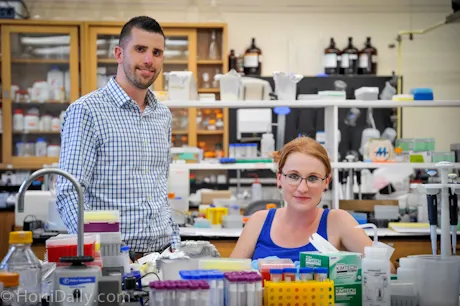“The two main activities we use this technology for are, firstly, marker-assisted selection, which is about using pieces of DNA information to predict which plants will be best, and allowing you to plant only the most desirable ones. Secondly, trait development, which is about creating plants with the characteristics that you want, but can't find,” explains Michael Pautler, Research Associate in the Applied Genomics lab at Vineland Research and Innovation Centre.

Research Associate Michael Pautler and Research Assistant Colleen Murphy in the Applied Genomics lab of Vineland Research and Innovation Centre
Pautler and his fellow researchers are currently involved in a special tomato breeding program to enhance Canadian greenhouse tomatoes varieties. “The main goal of the program is to obtain an improved and differentiated flavour, disease resistance, and low-light tolerance in tomatoes on the vine (TOV). We are looking for varieties with good yields and taste, adapted to the specific Canadian greenhouse environment.”
Pautler explained that the Canadian greenhouse industry demands these varieties as a result of the unique climate of the country. “In some parts of Canada, the climate during both summer and winter tends to be very harsh, so the crop needs to have enough endurance to withstand it.”
The goal of the breeding program is to create inbred lines and test them in the lab’s pre-commercial greenhouse. Vineland’s vegetable breeder Valerio Primomo and his team will only select varieties that are better-adapted and those that have the potential to create a successful hybrid for commercial growers.
Non-GMO
The lab’s trait development platform works on the basis of reverse genetics. “Instead of identifying traits in existing varieties and attempting to isolate them, we start with the gene in mind, based on a hypothesis that disrupting the gene will produce a novel trait. We use a process of random mutagenesis; a completely non-GMO approach which has been used for more than 70 years to induce variation,” says Pautler.For the tomato program, the Applied Genomics lab partners with academic collaborators from the University of Florida and the University of Toronto. “They gave us some good gene targets, which allow us to focus on translating basic research into commercial success. We are not trying to re-invent the wheel; partnerships with other institutions and companies are very important to us.”
For more information:
Vineland Research and Innovation Centre
Michael Pautler, PhD
Research Associate, Applied Genomics
michael.pautler@vinelandresearch.com
www.vinelandresearch.com
